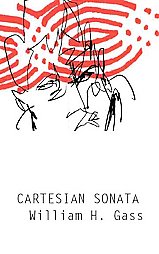DominionSections
Browse Articles
- IndependentMedia.ca
- MostlyWater.org
- Seven Oaks
- BASICS Newsletter
- Siafu
- Briarpatch Magazine
- The Leveller
- Groundwire
- Redwire Magazine
- Canadian Dimension
- CKDU News Collective
- Common Ground
- Shunpiking Magazine
- The Real News
- Our Times
- À babord !
- Blackfly Magazine
- Guerilla News Network
- The Other Side
- The Sunday Independent
- Vive le Canada
- Elements
- ACTivist Magazine
- The Tyee
- TML Daily
- New Socialist
- Relay (Socialist Project)
- Socialist Worker
- Socialist Action
- Rabble.ca
- Straight Goods
- Alternatives Journal
- This Magazine
- Dialogue Magazine
- Orato
- Rebel Youth
- NB Media Co-op
Radio
February Books
February 21, 2009
February Books
New works by Romanik and Gass

10 Things to Ask Yourself in Warsaw and Other Stories
Barbara Romanik
Enfield & Wizenty, 2008
Barbara Romanik’s short fiction rips along with streetwise verve, displaying an eclectic sense of style and some beguiling idiosyncrasies along the way. Several of the stories take place in the prairies (the author is described in her bio as a “Polish Canadian from Edmonton who now resides in Winnipeg”), but Romanik has an outsider’s eye for the details. Consider the way the prose comes alive when she begins to describe the prairie cityscape, as in the following evocation of Edmonton’s “slumburbia” in “Caught Up”:
At its worst, downtown lets itself go east of 97th street. It turns into a crumbling concrete, broken glass and rotting plywood on buildings, parking lots, and street alleys behind the restaurants, bars, and sexshops. There the pavement gives birth to resignation, a numbing stench of nuclear proportions, as moldy as cheese. Yet both Little Italy and Chinatown manage to rise to the top of it like cream. The wind and the snow, winter’s avenging angels, have covered most of it up and masked the stale odour.
Those who have lived in a prairie city will recognize a trace of themselves in “the pavement gives birth to resignation” amid a paragraph that perfectly conjures forth the bleak atrophy of life in a deep freeze. Intermingling interview transcripts, newspaper articles, advertisements, and other “found” documents, Romanik isn’t afraid to mix genres: a kind of patchwork that suits her characters’ conception of themselves as misfits. It also seems logical that this literary mash-up aesthetic would suit a longer form, meaning that if Romanik follows the most common career trajectory from a first short fiction collection, readers will be hearing about a novel at some point in the future.

Cartesian Sonata and Other Novellas
William H. Gass
Dalkey Archive Press, 2009
William H. Gass is one of the senior practitioners of American literary postmodernism, and he comes by it honestly. Of the works collected in Cartesian Sonata and Other Novellas (first published in 1998 and newly available from Dalkey Archive Press), “Cartesian Sonata” appeared in 1964, making Gass one of the early experimental writers to join in the movement’s mid-century flowering. Gass’s reputation was achieved not by appropriating a set of pre-established conventions, as is the case with many “postmodern” writers (an increasingly empty descriptor) emerging even today, but through the gradual refinement of an aesthetic and years spent reading and writing on the vanguard. The book collection in Gass’s St. Louis home reportedly contains upwards of 19,000.
It’s a fascinating glimpse into the foundation of these techniques, in abundance over the last several decades to the point of cliché, at play for the first time. The title novella comes soaked in the kind of metafictional conceit instantly recognizable as one of the defining hallmarks of the postmodern sensibility: a story begins, and almost immediately the anxious writer’s own personality insinuates itself within the narration, explaining, fretting, and ultimately deconstructing. But Gass’s work is not without its straightforward rewards. For example, a passage in “The Master of Secret Revenges” enunciates with glittering precision the ethos that drove postwar writers of Gass’s ilk toward the subversion of established fiction writing technique:
[R]evelations are rarely the result of the minds climbing a ladder, each clear and definitely placed rung surmounted foot after foothold like a fireman performing a rescue; they are achieved more in the devious way cream rises to the top of its countless globules of fat are floating free and slipping upward . . . until gradually, nearly unnoticed, the globs form a mass which forces the blue milk beneath, whereupon the sweet cream crowns the carton, waiting to be skimmed.
Gass’s is the kind of work born of an artist’s total immersion within a form, to the point that, at some stage of development, the artistic enterprise begins seeking to change that form’s rules entirely. The latter novellas are the most controlled execution of Gass’s style and, as a result, feel the most accomplished. In general, the novella demonstrates a peculiar insularity, transient yet sustained, that sets it apart from the short story, perfectly suiting Gass’s more mature sensibility.
Related articles:
By the same author:
Comments
Archived Site
The Dominion is a monthly paper published by an incipient network of independent journalists in Canada. It aims to provide accurate, critical coverage that is accountable to its readers and the subjects it tackles. Taking its name from Canada's official status as both a colony and a colonial force, the Dominion examines politics, culture and daily life with a view to understanding the exercise of power.